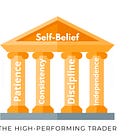Confidence Without Results
The Thursday Trader's Tip edition offers to-the-point trading performance advice that can be read under 5 minutes.
Leverage Trading Accountability with the Paid Plan:

One of the hardest things to accept in trading?
It doesn’t work like Newton’s Cradle.
In Newton’s Cradle, energy transfers with perfect precision — one ball strikes, one ball reacts. It’s a textbook example of cause and effect.
But in trading, you can follow your system to the letter, take a clean setup, execute flawlessly… and still get nothing in return.
Then, with a setup that looks average at best, the market suddenly rewards you with a disproportionate gain.
It defies logic. And yet — that’s the nature of this game.
For some, it’s the most frustrating part.
For others, it’s where true scalability lives.
The real danger of chasing cause-and-effect in trading is this:
When the outcomes are favorable, confidence is high. But the moment results shift, that same confidence unravels.
Discipline slips. Control is lost. Decision-making fractures.
Why?
Because their confidence wasn’t rooted in process.
It was rooted in the illusion of predictability.
Confidence Built on Results Will Always Fail
It’s easy to be disciplined when your trades are working.
But that’s not the biggest proof of discipline and composure. That’s just an easier-to-accept scenario—the market is playing along, all is good.
The real test is when you follow your process, take a good trade, and still lose. For days or weeks in a row;
It is to stay neutral when your plan doesn't “pay off.”
These traders think:
Good performance = bearable cause-and-effect relationship.
They might have one or two losses as long as it’s not more than that. The tolerance to discomfort is minimal.
Randomness Cuts Both Ways
This lack of cause and effect (typical of perfectionists, btw) isn’t just a downside. It works in your favor, too.
You can have a rough start to the week, and then one day, one setup, changes everything.
But many traders don’t trust that upside.
They limit themselves after a good trade: “I had a winner, I’m closing the charts.” Or after just one trade: “One and done for the day”
(I wrote a post about how strict rules like these limit rather than help your trading results here.)
They forget that trading is a game of inconsistency.
Some days you lose small.
Some days you scratch.
And some days — if you’re open to it — you make disproportionate gains.
The key is being open to it — and positioning yourself for it.
Because in a game where nothing is guaranteed, this is the closest you get:
You won’t win every day. But you’ll never win if you’re not in position when the opportunity comes.
And the probability of that moment coming — if you keep showing up — is higher than you think.
In Closing
If you take one thing away from this post, let it be this:
Detach your sense of control from outcomes. And trust that the edge you’ve built doesn’t need to be understood to be real.
You’re not here to make sense of the market.
You’re here to stay available when it makes sense for you.
Peaceful trading,
Sara
If you enjoyed the post, consider upgrading to the paid plan for full access to the coaching processes, mental frameworks, and downloadable templates I use with my 1:1 clients.
Plus, access to live webinars!
Related Reads:






